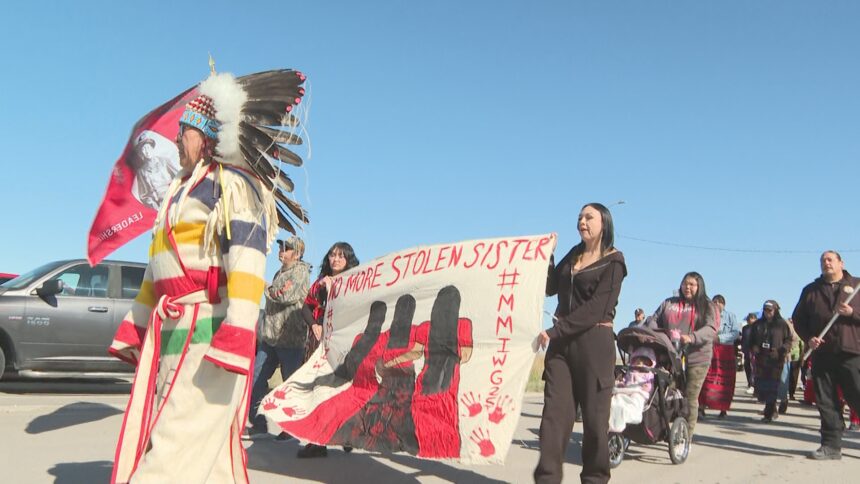The haunting sight of red dresses hanging from trees and hundreds of community members walking in solidarity created a powerful visual statement across the Blood Tribe Reserve this weekend. As dawn broke over southern Alberta on Sunday, residents gathered for the annual Red Dress Day memorial walk, a solemn tribute to missing and murdered Indigenous women and girls that has grown from a grassroots movement to a nationwide day of remembrance.
“This isn’t just about remembering—it’s about demanding justice and creating change,” said Kainai Board of Education coordinator Pam Little Bear, whose organization helped coordinate the event alongside community volunteers. “Every red dress represents a sister, a mother, a daughter who never came home.”
The memorial walk, which began at the Kainai High School and wound through the community, drew participants from across generations. Elders who have witnessed decades of loss walked alongside children who are learning about their community’s painful history. Many participants wore red clothing or carried photographs of loved ones who have disappeared or been murdered.
Statistics from the Native Women’s Association of Canada show Indigenous women and girls represent approximately 10 percent of all female homicides in Canada, despite making up just 4 percent of the female population. This disproportionate violence has been recognized by the federal government as a national crisis, though activists and community leaders argue that concrete action has been too slow in coming.
Blood Tribe Police Chief Kyle Melting Tallow, who participated in the walk, emphasized the importance of continued awareness. “These aren’t just statistics—these are our people. The pain ripples through generations, and we need sustained commitment from all levels of government and law enforcement to address this crisis.”
For many attendees, the event carried deep personal significance. Mary Black Plume, who lost her niece three years ago in a case that remains unsolved, described the walk as both painful and healing. “Coming together like this gives us strength. It reminds us that we aren’t alone in our grief or in our fight for justice.”
The day’s events included traditional prayers, song, and drumming. Community leaders spoke about ongoing initiatives to protect vulnerable women and girls, including new safety programs in schools and enhanced reporting systems for missing persons within tribal communities.
Red Dress Day, officially recognized as the National Day of Awareness for Missing and Murdered Indigenous Women and Girls, originated with Métis artist Jaime Black’s REDress Project in 2010. The installation art project featured empty red dresses hanging in public spaces to represent the missing women. The symbolic power of these empty garments has since transformed into a nationwide movement that has gained significant political attention.
Blood Tribe council member Dorothy First Rider highlighted the importance of addressing systemic issues. “We must look at the root causes—colonization, intergenerational trauma, inadequate policing responses, and ongoing socioeconomic challenges. This isn’t just an Indigenous issue; this is a Canadian human rights crisis.”
As the sun set on the event, participants gathered for a community feast where stories were shared and connections strengthened. Young women from the community performed a traditional dance, their movements a testament to resilience and cultural continuity despite generations of trauma.
While the annual event centers on commemoration, organizers emphasized that their work continues year-round. “Today is powerful, but we need this energy and commitment every day,” said Lance Tailfeathers, a local advocate who helps coordinate support services for families of missing persons. “The real measure of progress will be when we no longer need to hold these walks because our women and girls are safe.”
As Canada continues to reckon with its colonial past and the ongoing disparities faced by Indigenous communities, events like the Blood Tribe’s Red Dress Day memorial walk serve as both a painful reminder of justice delayed and a powerful demonstration of community resilience. What will it take for Canadians to move beyond acknowledgment of this crisis to implementing the systemic changes needed to ensure the safety of Indigenous women and girls?


















